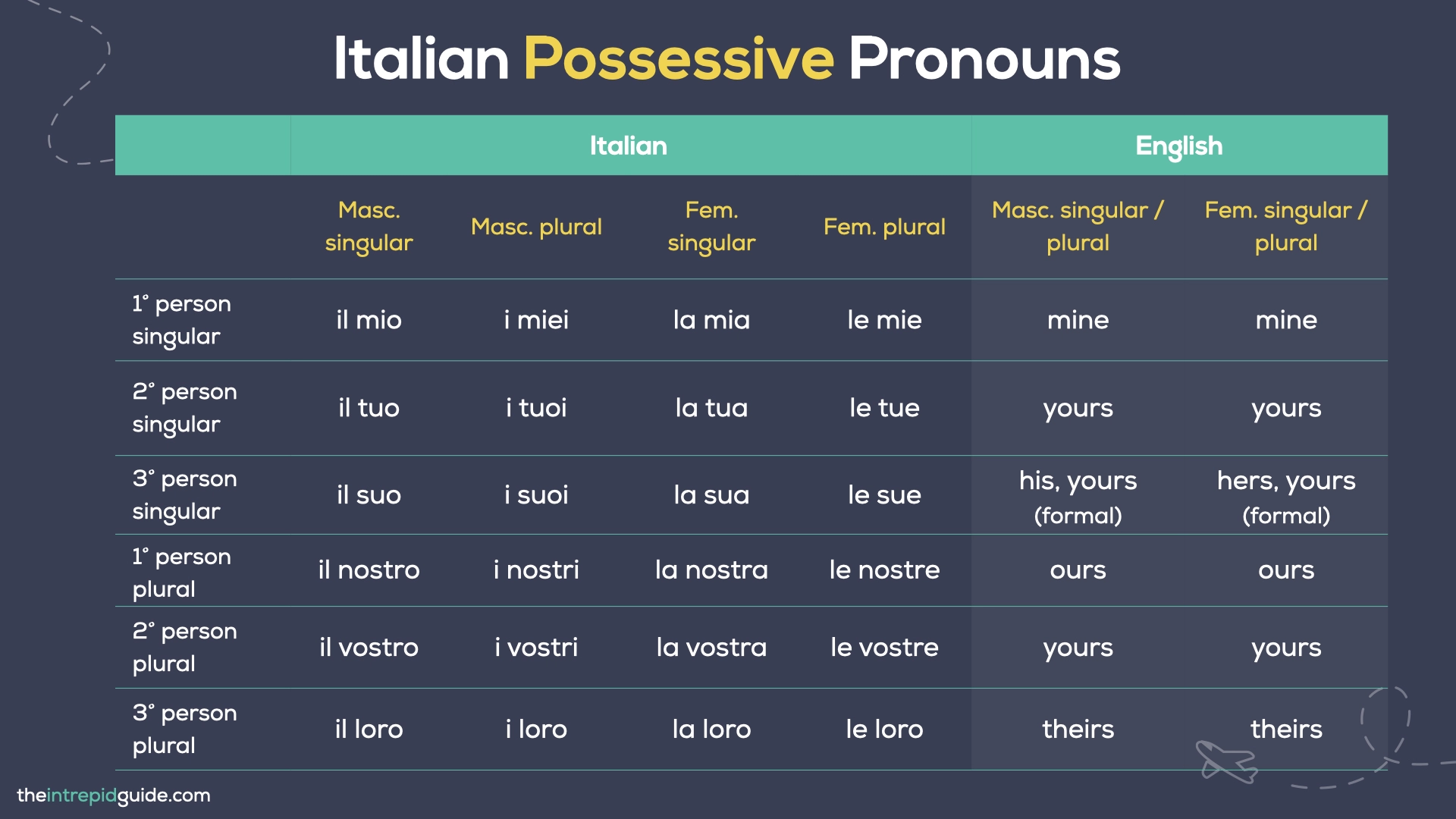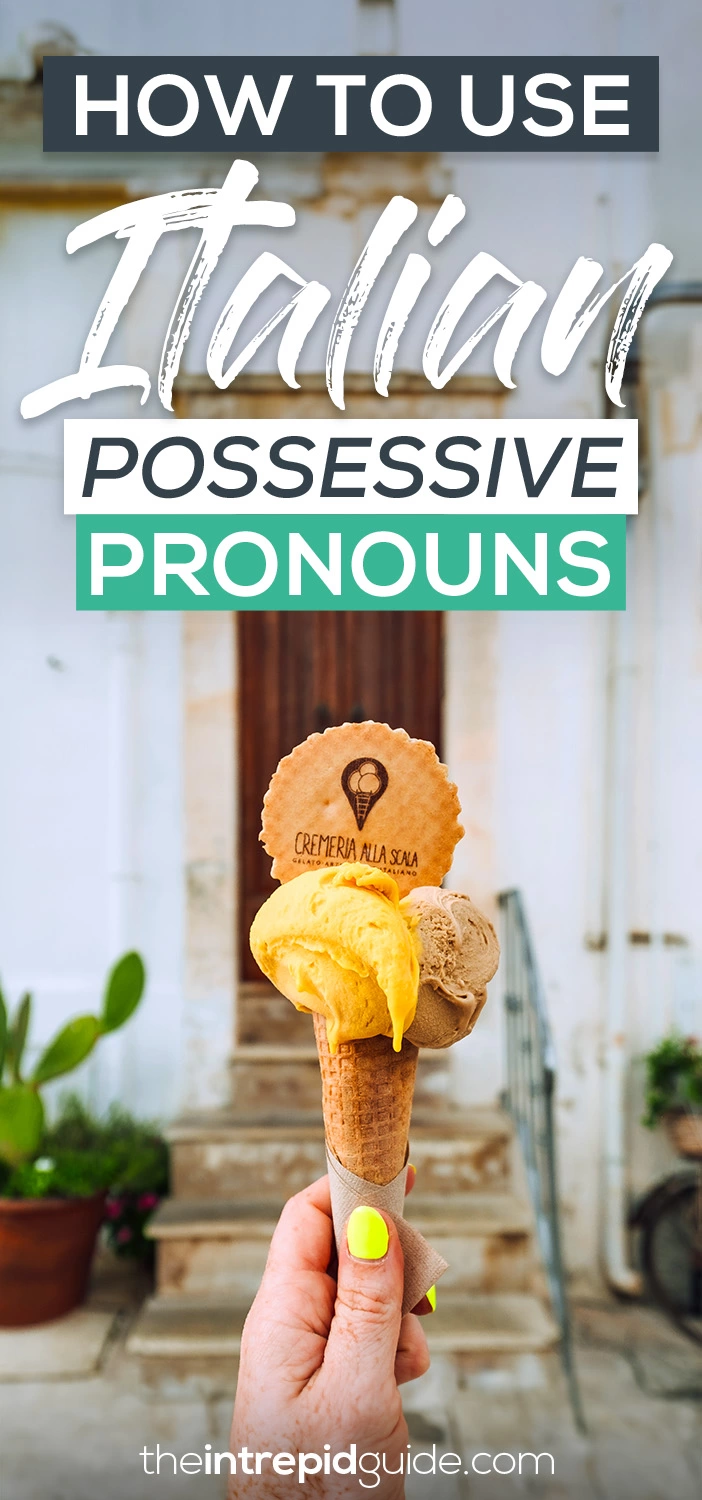Imagine you are strolling through the picturesque streets of Florence, looking up in awe at the magnificent buildings around you, and suddenly, a friendly local approaches you, holding a scarf and asks, È la tua? And just like that, you instantly realize you unknowingly dropped your beloved scarf, while being introduced to the word tua, a new Italian pronoun called an Italian possessive pronoun, the equivalent to saying ‘yours’ in English.
This guide will help you understand how to use Italian possessive pronouns correctly in various sentences, so your Italian sounds more fluent and authentic. To see how much you’ve learned, don’t forget to complete the free quiz at the end of this lesson to test your new-found knowledge!
Before we get started, make sure you download your FREE PDF cheat-sheet for this lesson which includes a practical summary of everything you’ll learn in this guide. Just enter your email below and I’ll send it to you straight away.
By the way, want to improve your Italian quickly and having fun doing it?
I thought so.
If you’re a beginner, I recommend Intrepid Italian, my comprehensive self-paced programme that teaches you through the power of my unique 80/20 method. The course covers everything you need to know as a beginner in Italian (including how to use pronouns). Join now for lifetime access and my 30-Day “Celebrate with a Spritz” money-back guarantee by clicking here.
Or if you’re already at the intermediate level, why not enrol in Intrepid Italian for Advanced Beginners (A2) or Intrepid Italian for Intermediates (B1), my more advanced programmes that helps you master the trickiest aspects of Italian grammar while as you edge closer to fluency in Italian.
When you start learning Italian, it’s pretty common to keep repeating the same basic phrases and words, but if you’re gunning for fluency, it’s time to shake things up a bit. The key? Familiarize yourself with Italian pronouns to inject rhythm into your sentences!
Cominciamo! (Let’s get started!)
What are Italian Possessive Pronouns?
In Italian, possessive pronouns are essential for expressing ownership or belonging, which are common concepts in daily conversation. Like all Italian pronouns, they replace nouns to prevent repetition, and specify who owns or is associated with the person, animal, or object referred to by the noun.
Here are some examples:
- Io e Luca abbiamo ordinato un gelato ma il mio era più piccolo del suo. (Luca and I ordered an ice-cream but mine was smaller than his.)
Here, mio replaces il mio gelato.
- Mia sorella prende sempre il mio ombrello perché dimentica il suo in giro. (My sister always takes my umbrella because she leaves hers around.)
Here, suo replaces il suo ombrello.
- Che macchina usiamo per andare al concerto domani? La mia o la vostra? (Which car should we use to go to the concert tomorrow? Mine or yours?)
Here, mia and vostra stand for la mia macchina and la vostra macchina respectively.
Keep reading to master the basics of Italian possessive pronouns, so you can chat like a local. And don’t miss the fun quiz at the end of this guide to see how much you’ve picked up!
Italian Possessive Pronouns Chart
Here are the possessive pronouns in Italian. They vary based on gender (masculine/feminine) and number (singular/plural) of the noun they relate to. One key point to remember is that the third-person plural pronoun loro remains consistent in all uses.
| Italian Possessive Pronouns | ||||||
|---|---|---|---|---|---|---|
| Italian | English | |||||
| Masc. singular | Masc. plural | Fem. singular | Fem. plural | Masc. singular / plural | Fem. singular / plural | |
| 1° person singular | il mio | i miei | la mia | le mie | mine | mine |
| 2° person singular | il tuo | i tuoi | la tua | le tue | yours | yours |
| 3° person singular | il suo | i suoi | la sua | le sue | his, yours (polite) | hers, yours (polite) |
| 1° person plural | il nostro | i nostri | la nostra | le nostre | ours | ours |
| 2° person plural | il vostro | i vostri | la vostra | le vostre | yours | yours |
| 3° person plural | il loro | i loro | la loro | le loro | theirs | theirs |
How to Use Italian Possessive Pronouns
As you can see, Italian possessive pronouns are similar to possessive adjectives, but their roles in sentences are different:
- Possessive Adjectives are used with nouns to show ownership (e.g., i nostri amici – our friends; il mio ragazzo – my boyfriend).
- Possessive Pronouns replace nouns entirely (e.g., i nostri amici sono più simpatici dei vostri – our friends are nicer than yours; il mio ragazzo è più figo del tuo – my boyfriend is cooler than yours).
Additionally, possessive pronouns in Italian always require a definite article (like la, il, le, etc. – “the” in English) before them. For example:
- Se hai dimenticato il cellulare, puoi usare il mio. (If you forgot your phone, you can use mine.)
- Anna ha rotto la bicicletta, così l’ho accompagnata a casa con la mia. (Anna broke her bicycle, so I took her home with mine.)
Special Uses of Italian Possessive Pronouns
In Italian, possessive pronouns are often used in a unique way, where they stand alone without a directly associated noun. This usage, which is more common in casual conversations, conveys specific meanings that are usually easy to understand from the context.
Let’s explore some examples:
- Mattia è andato dai suoi per il fine settimana. (Mattia went to his [parents] for the weekend.)
Suoi here implies genitori, meaning that Mattia went to his parents’ house.
- Finalmente sono arrivati i nostri! (Finally, our [people] have arrived!)
In this case, nostri represents gli alleati, indicating the arrival of supporters.
- Non ha avuto la possibilità di dire la sua. (He didn’t have the chance to express his [opinion]).
Sua suggests opinione, meaning the guy couldn’t express his opinion.
- Brindiamo alla nostra/vostra. (Let’s toast to our/your [health].)
Nostra/vostra refer to la salute and is commonly used when celebrating.
- Giulia ne ha combinata una delle sue. (Giulia has done one of his [things].)
Sue implies azioni, suggesting actions characteristic of Giulia.
- Per non licenziarla, ci ho rimesso del mio. (To avoid firing her, I lost my [money].)
Mio indicates soldi (money), revealing the speaker’s financial effort.
Italian Possessive Pronouns Quiz
Let’s test your knowledge of Italian possessive pronouns. Fill in the blanks in these sentences using the correct possessive pronoun.
If you found this lesson powerful, then you’ll love Intrepid Italian, my series of online self-paced video courses that break down everything you need to know about Italian using my 80/20 method. Visit IntrepidItalian.com for more details.
 Are you a beginner or an intermediate Italian learner? Got a trip coming up or want to communicate with your Italian partner or relatives in Italian? Learn Italian with my unique 80/20 method
Are you a beginner or an intermediate Italian learner? Got a trip coming up or want to communicate with your Italian partner or relatives in Italian? Learn Italian with my unique 80/20 method
Registrations are now open to join Intrepid Italian, my new series of online video courses that use my unique 80/20 method. You’ll go from a shy, confused beginner to a proficient and confident intermediate speaker, with me as your trusty guide.
You’ll finally be able to connect with your Italian partner, speak to your relatives and enjoy authentic travel experiences in Italy that you’ve always dreamed of, and so much more.
As a native English speaker who learned Italian as an adult, I know what it’s like to feel hopeless and lack the confidence to speak. I know what it’s like to start from scratch and to even go back to absolute basics and learn what a verb is!
Intrepid Italian was created with YOU in mind. I use my working knowledge of the English language to help you get into the ‘Italian mindset’ so you can avoid the common pitfalls and errors English speakers make – because I made them once too! I break everything down in such a way that it ‘clicks’ and just makes sense.
No matter what your level is, there is an Intrepid Italian course for you, including:
- 🇮🇹 Intrepid Italian for Beginners (A1)
- 🇮🇹 Intrepid Italian for Advanced Beginners (A2)
- 🇮🇹 Intrepid Italian for Intermediates (B1)
You can join 1, 2, or all 3 courses, it’s entirely up to you. The best part is that you have lifetime access so you learn anytime, anywhere and on any device.
As your guide, I walk you through each lesson, step-by-step, using my unique 80/20 method. My approach is different from traditional methods because I teach you the most important 20% of the language right from the beginning so you can start to speak straight away.
Each course includes video lessons, audio exercises, downloadable worksheets, bonus guides, a private support community, and lifetime access all designed to streamline your learning while having fun.
It even comes with my famous “Celebrate with a Spritz Guarantee”. After 30 days of using Intrepid Italian, if you don’t want to celebrate your new-found Italian skills with an Aperol Spritz, you don’t have to pay a penny! Cheers! 🥂
Join Intrepid Italian here and start learning today!
Ci vediamo lì! (See you there!)
Learning Italian? Check out these Italian language guides
- Italian for Beginners | How to Learn Italian in 3 Simple Steps
- TOP 100 Most Common Italian Words (Plus PDF Cheat-Sheet & Quiz)
- Italian Prepositions:The Only Guide You’ll Ever Need (PLUS Chart)
- 17 Weird Italian Superstitions Italians ACTUALLY Live By
- 17 Must-Know Italian Hand Gestures: The Ultimate Guide
- 10 Ways Natives REALLY Say ‘You’re Welcome’ in Italian
- How to say ‘Please’ in Italian in 9 Ways Like a Native
- 41 Italian Greetings: How to Say ‘Hello’ in Italian Like a Local
- 125 Most Common Italian Phrases for Travel You’ll Ever Need [PLUS Printable]
- 8 DEADLY mistakes in Italian (& How to Avoid Them)
- How to Conjugate Italian Verbs in 3 Simple Steps [Italian for Beginners]
- Is Italian Hard to Learn? 7 Common Mistakes & How to Avoid Them
- Master Days of the Week in Italian (7 Simple Memory Hacks)
- Italian Numbers: How to Count in Italian From 0 to 1 Billion (Plus PDF Download)
- How to Order Food & Drinks in Italian [Italian for Beginners]
- 15 Italian Words You Should NEVER Mispronounce [& How Not To]
- 11 Effective Hacks That’ll Help You Learn Italian So Much Faster
- Top 14 Italian Words You Should NEVER Say [& What to Use Instead]
- 20 Hilarious Everyday Italian Expressions You Should Use
- Romanesco: 25 Cool Roman Dialect Words You Should Use in Rome
- 10 Reasons Why Learning Italian Will Change Your Life
- 10 Italian Expressions Italians Love Saying
- 10 Italian Phrases That Will Instantly Make You Sound more Italian
- Funny Italian Sayings: 26 Food-Related Insults You Won’t Forget
- 15 Romantic Italian Films That’ll Make You Love Italy Even More
- How to Master Common Italian Phrases for Travel (Like a Local!)
Like it? Pin it for later!
Over to you!
Did you enjoy this lesson? Do you have a question? Let me know using the comments section below or join me on social media @intrepidguide or @intrepiditalian to start a conversation.
Thanks for reading and I hope you enjoyed this post.
Like what you see? Subscribe using the form below to have all of my posts delivered directly to your email.




